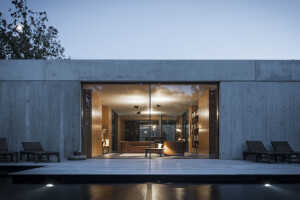This is a house about monumentality, views, privacy, light, air and connection to an elevated garden terrace all within the constrained context and density of the eastern suburbs. Despite its size and aspirations it contains lessons of how to maintain high standards of living whilst occupying a smaller footprint of land, an increasingly important issue as density increases in the city and surrounds.
The ambition for this house was to create a substantial family home that took best advantage of a challenging south west facing site on Sydney Harbour. The house was to be appropriate for a family of four and also to host large parties with ease.
The site for the house is long, narrow, oriented to the south west and with a considerable fall towards the water. It was also overlooked by houses and apartment buildings to the north, south and east. This context along with the clients brief underpinned the design and character of the house.
The depth and orientation of the house meant that only the westernmost rooms had access to views over the harbour whilst the eastern part of the house has the greatest access to northern light.
Our response was to locate the major living areas of the house to the west, oriented towards the view. The building sides are folded to bring these views deeper into the house whilst providing privacy from the neighbouring houses.
A double height balcony with operable blinds provides outdoor entertaining spaces along wth protection from the westerly sun.
This space is reflected by a double height library to the east of the house which provides drama to the interior and allows light deep into the building. It operates as a ‘hall’ in the manner of a traditional manor house.
This hall and stairway also unites the four levels of the house as the building steps down the hillside towards the harbour. The top floor contains the main bedroom suite, the second floor contains children and guest living, the first floor contains the major living spaces of the house at half level below the street and the ground floor provides entertaining spaces and connections to a raised garden terrace.
The architectural character of the house also transitions from east to west, from public and private to open and expansive. The street façade is closed and made of substantial, traditional materials such as sandstone, concrete and copper whilst the western façade takes advantage of the structural possibilities and expression of concrete and steel to open up to the spectacular view. The folding of the side facades facilitates a seamless transition between these two related but different characters. Steel hoods externally and operable timber louvres internally assist in providing appropriate screening of neighbour’s views.
The house occupies a similar envelope to that of a previously approved apartment development on the site. The project is modelled within this envelope to improve its’ presentation to both the street and the harbour and to improve solar and view access to the adjacent properties.


































